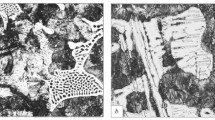Conclusions
-
1.
In order to obtain macrogeometrical stability and the formation of protective structures of elevated wear resistance in cylinder liners of manganese cast iron, heat treatment including high-frequency heating of the liners combined with hardening by quenching is necessary.
-
2.
The amount of retained austenite in cast iron hardened using HFC heating must be 34–36%. Decrease or increase of this amount of Aret in the martensitic cast iron base decreases the resistance to wear and scoring of cast iron liners with a high concentration of manganese (∼2.0%).
-
3.
The working-in regimen has a strong effect on the ability of the rubbing surfaces to form protective secondary structures of optimal phase composition. Preliminary "conditioning" of the surfaces by working-in at low specific loads, using a definite number of cycles, is necessary to guarantee compatibility of the elements of the rubbing pair.
Similar content being viewed by others
Literature cited
B. M. Astashkevich, "Mechanism of wear in the piston-cylinder components of diesel locomotives," in: Improvement of the Wear Resistance of Internal Combustion Engine Components, Mashinostroenie, Moscow (1972), pp. 5–12.
I. M. Lyubarskii and L. S. Palatnik, Metal Physics of Friction [in Russian], Metallurgiya, Moscow (1976).
L. M. Rybakova and L. I. Kuksenova, Structure and Wear Resistance of Metals [in Russian], Mashinostroenie, Moscow (1982).
N. A. Bushe and V. V. Kopyt'ko, Compatibility of Rubbing Surfaces [in Russian], Nauka, Moscow (1981).
V. E. Kanarchuk, Adaption of Materials to Dynamic Effects [in Russian], Nauka Dumka, Kiev (1986).
M. A. Grigor'ev, K. A. Berner, V. D. Zelenova, et al., "Scoring resistance of diesel cylinder liners and its evaluation," Vestn. Mashinostr. No. 11, 19–21 (1986).
O. M. Eparkhin, G. A. Maznova, and G. D. Chernyshev, "Effect of the quenching temperature attained by HFC on the structure and properties of manganese cast iron," Dep. VNIITÉMR, No. 302, Moscow (1988).
O. M. Eparkhin, V. M. Astashkevich, and N. I. Vershinina, "Stabilization of the macrogeometry of cast iron cylinder liners upon heat treatment," Vestn. VNIIZhT, No. 1, 35–37 (1990).
Yu. M. Astashkevich, T. V. Larin, V. P. Lukoshenko, and I. E. Gal', Vestn. Mashinostr., No. 10, 13–18 (1976).
Additional information
VNIIZhT. Translated from Metallovedenie i Termicheskaya Obrabotka Metallov, No. 12, pp. 28–31, December, 1990.
Rights and permissions
About this article
Cite this article
Astashkevich, B.M., Eparkhin, O.M. & Maznova, G.A. Effect of structure on the wear of quenched martensitic cast iron for diesel cylinder liners. Met Sci Heat Treat 32, 931–934 (1990). https://doi.org/10.1007/BF00700086
Issue Date:
DOI: https://doi.org/10.1007/BF00700086




